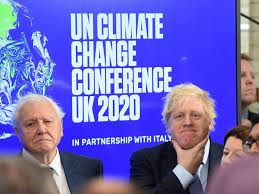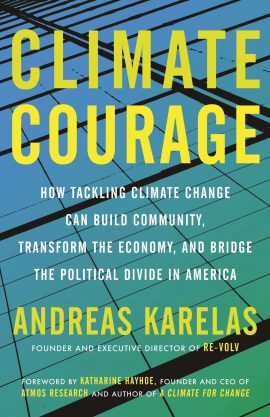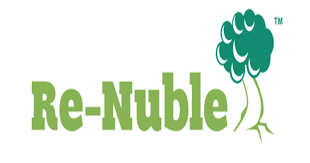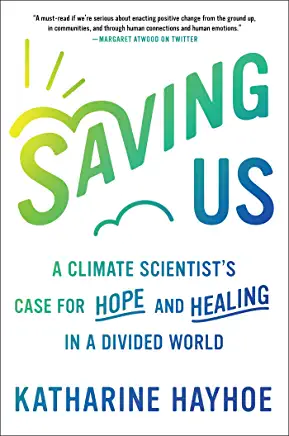
Climate Change 2.0
Like most people I know, I was not overwhelmed by what the world’s leaders accomplished at last month’s COP 26 summit in Glasgow.
 On the positive side of the ledger, made it clear that we are approaching many points of no return when it comes to climate change and have probably already crossed some of them, starting with the fate of handful of island nations that literally may not survive. Nonetheless, the steps world leaders took fell far short of what we will need to do by the end of this decade, let alone over the next half century.
On the positive side of the ledger, made it clear that we are approaching many points of no return when it comes to climate change and have probably already crossed some of them, starting with the fate of handful of island nations that literally may not survive. Nonetheless, the steps world leaders took fell far short of what we will need to do by the end of this decade, let alone over the next half century.
Unlike most people I know and talked with while the summit was under way, I actually feel more hopeful about our prospects.
You can’t see (much of) that in what happened in Scotland. However, if you both take a look at what didn’t happen there and then add to it some promising trends I’ve learned about from a new generation of climate activists, you can see why I’m more optimistic than the results in Glasgow would warrant and that I’m optimistic in ways that reflect the same basic trends I’m working for and writing about in Connecting the Dots, which is slowly coming together as a book.
Gloom and Doom 101–2020s Style
We remain stuck on what feels like a collision course with catastrophe. There are lots of reasons why that’s the case. Here, I will only deal with one of them, which is also the one I think the dot connecters covered in my book might be able to do something about..
Today’s activists have reached the climate change equivalent of a conclusion I had to make about peacebuilding in the late 1980s. At the first national conference of what is now the Peace and Justice Studies Association, George Lopez used his presidential address to chide us for focusing primarily on what he called Doom and Gloom 101 in our classes and in our movement building. Instead, as I rather pompously entitled my first publication in peace studies a few months later, we had to offer people a “rational basis for hope.”
The first generation of climate activists has succeeded in taking us on the first leg of the journey toward sustainability. Everyone from Al Gore to Greta Thunberg to Sir David Attenborough have taught millions of us about climate change and urged us all to do something about it.
And, they have enjoyed huge success on the first leg of our journey toward sustainability.
At long last, global public opinion is beginning to catch up with the science. Aside from a few climate change skeptics, just about everyone agrees that we have to act—and act now. Polls conducted each year by Yale and George Mason universities show that the vast majority of Americans know that climate change poses a serious threat, and a growing number of us are convinced that it already touches our personal lives. Some show that even a majority of Republicans believed we don’t have much time before we do irreparable harm to the earth’s ecosystems.
Most of us, too, have altered some of what we do. Most of us recycle. More of us base our diets on organic, locally grown, and plant based foods. Everything from our cars to our iPads is built more efficiently than even a decade ago.
Meanwhile, some public and private sector elites are also beginning to change, too. Even the Saudi government is talking about becoming carbon neutral. Company after company now talk about how they are doing their part. You’ve all seen the ads about tech giants shifting to renewables to power their data farms or automobile companies which plan to phase out the production of internal combustion vehicles by the middle of the 2030s, if not before. Dozens of state and local governments in the United States have taken major steps toward doing their part, including the deep red city of Georgetown TX which gets all of its electricity from renewable sources.
To use a term I’ve borrowed from my younger activist friends, much of this is performative.
But, much of it is real, too. It is also hard to imagine companies like Microsoft or General Motors making commitments like these a decade or so ago, let alone a petri-state like Saudi Arabia.
As impressive as their efforts have been, however, the fact is that we still face two problems. First and most obviously, we are losing the race against time. Second and in keeping with the overall argument of the book I’m writing, they haven’t offered average citizens constructive ways of shifting the climate momentum in which they could see that they were making a difference.
As a result, the climate change movement is quickly approaching a fork in the clichéd road. It hasn’t demonstrated the ability to build the kinds of grass roots support that could produce the political will elites need to enact the kinds of policies that will slow down the rate of greenhouse gas emissions before it is too late.
At about the same time that I heard Lopez’s speech, I read an article by Peter Sandman and JoAnn Valenti whose titled I borrowed to start this section. If I’m right, we are facing a similar situation today. As was the case then, Gloom and Doom 101 style arguments about climate change can frighten people, attract their interest, and even get them out into the streets for a while. Fear-driven engagement, however, does not tend to last unless it is connected to an achievable set of goals. Progress toward them may be incremental at first, but if each step leads to a bigger and more audacious one, we become more and more empowered along the way.
Climate Change 2.0
That’s where what I like to call Climate Change 2.0 movements come into play. As far as I can tell, next to no one uses the term Climate Change 2.0. Instead, an internet search brings up tons of references to our need to keep global warming below 2.0 degrees Celsius but precious few about a new kind of environmental movement.
But such a term should exist to describe some new and promising initiatives that still remain largely below the media’s radar screen but are striking themes that are at the heart of my book.
It all starts with some new scientific breakthroughs which I’ll mention here but that are also too far from my own expertise to explore in any depth. Two examples should suffice for our purposes here. Each has a link you can explore it you want to learn more.
 A few weeks ago, I read and reviewed Azeem Azhar’s new book, The Exponential Age. He both documents how quickly many aspects of our lives are changing in ways that go far beyond the implications of phenomena like Moore’s Law. The affordances of those changes—including sustainable energy—open the door to a wholly new society if—and it’s a very big if—our social institutions and norms can keep pace.
A few weeks ago, I read and reviewed Azeem Azhar’s new book, The Exponential Age. He both documents how quickly many aspects of our lives are changing in ways that go far beyond the implications of phenomena like Moore’s Law. The affordances of those changes—including sustainable energy—open the door to a wholly new society if—and it’s a very big if—our social institutions and norms can keep pace.
Saul Griffith and others have focused more on climate change and argued that we are about to enter a period in which renewably sourced electricity will become so plentiful and so cheap that we can sustain our current standards of living. What’s more, the new abundance will allow us to tackle any number of other festering problems at home and around the world.
In the simplest terms, the cost of alternative forms of energy is declining exponentially. By the end of this decade, solar, wind, and (with more controversy) nuclear power will be cheap enough to meet just about all of our energy needs. There are plenty of technological and political challenges here, including the need to modernize the electrical grid in ways that are likely to put us in conflict with the existing utilities or the need to provide adequate storage so that we have enough electricity for times when the sun doesn’t shine and the winds don’t blow.
As you will see in the rest of this blog and more fully in the chapter I’m writing, these looming technological advances and the first glimpses of a Climate Change 2.0 have begun to answer the challenge Sandman and Valenti posed—and we failed to answer—thirty-five years ago.
I am not saying that they will succeed, only that they can.
Indeed, anyone who argues that the odds are good that we will meet the climate challenge should be treated with a hefty dose of skepticism, if not more.
Everything from public opinion polls to research on neuroscience and human evolution suggests that even the most committed among us are not prepared for the long slog that addressing climate change will entail. Not only do we not easily think in terms of long-term commitments, but we are locked into narratives that equate a positive response to climate change with sacrifices that we will have to makes in our quality of life in the here and now.
To make, they call for a new kind of movement that is quite different from the ones I’ve been part of for most of my political life—a topic that I’ll take up in my next blog post. For now, it’s enough to see that building the kind of lasting commitment the climate movement needs will only be possible if we do at least four things. As I’ll show you in the rest of this post (and in the chapter I’ll be writing in the next few weeks), some activists are beginning to tackle each of them.
- Start by creating a plausible vision of what a sustainable world that doesn’t depend on fossil fuels would be like, including the ways in which it would be dramatically better than the one we live in today
- Offer people things to do that can lead to tangible progress initially in their communities and, eventually, nationally and globally
- Link action on climate change to the other issues troubling our country and our planet
- Reach out to the “red” half of the country that is indifferent, if not downright hostile to the kinds of efforts discussed either at Glasgow or in this blog post.
And, as you are about to see, we have taken at least a few “baby steps” in each of these directions.
A Powerful, Positive Vision
To be honest, we didn’t come close to providing a powerful vision of a better future either in the 1980s or the 1960s when I “majored” in ending the war in Vietnam while in college and grad school. Terms like a world beyond war remained pipe dreams (or worse) in most people’s eyes.
The creative community is beginning to fill that gap by doing its part to get past Gloom and Doom 101 which has been the hallmark of so many of the dystopian films and science fiction novels that are on the market today.
Critical here is Kim Stanley Robinson’s most recent novel, Ministry of the Future. I had never heard of KSR (as he is known to his zillions of fans) until his TED talk on the book appeared on my podcast list during one of my daily pandemic-era walks over the summer. I then read the novel and loved it.
Without spoiling the plot, it looks back at the history of a once tiny UN agency from 2071 and tells the story of what it staff and others did to stop climate change dead in its tracks. Parts of the story are a bit implausible (e.g., high tech dirigibles), but the political trajectory it paints makes sense. Initial progress is limited. People get dispirited from time to time. But, we get there. With, of course, a couple of love stories.
One of my colleagues who, unlike me, has been a KSR fan for years convinced the PeaceCon team to have him deliver the final keynote address at this year’s conference on the afternoon of January 28, 2022.
And yes, the event is open to anyone who wants to come, but you must register at https://www.allianceforpeacebuilding.org/peaceconat10. So, do come
Start With Bright Spots
Because none of us is likely to get a job at the Ministry for the Future or any such organization in the days to come, we have to move on to the second point. Time and time again, we hear stories of people who want to do something about climate change but can’t identify anything they could do that would make a difference in the larger scheme of things. As I will be arguing throughout the book and in the practical work that is growing out of it, we need to build on the admittedly few success stories we can point to in the world today
 For example, when I was picking up my grandkids at school the other day, one of their friends was wearing a “reduce, reuse, recycle” t-shirt. As her mother and I began to talk, she made it clear that she knew that t-shirts weren’t enough. So, I began talking about Re-Volv and the broader implications of the book its founder, Andreas Karelas, wrote, Climate Courage, which I’ve reviewed elsewhere.
For example, when I was picking up my grandkids at school the other day, one of their friends was wearing a “reduce, reuse, recycle” t-shirt. As her mother and I began to talk, she made it clear that she knew that t-shirts weren’t enough. So, I began talking about Re-Volv and the broader implications of the book its founder, Andreas Karelas, wrote, Climate Courage, which I’ve reviewed elsewhere.
It is one of a growing number of organizations that are developing projects that average citizens could get involved in and see a constructive response to climate change grow before their very eyes.
On one level, Re-Volv raises capital that it loans to non-profits who want to install solar power cells but couldn’t otherwise afford to do so. So far, it has raised and deployed over $10,000,000 in loans and helped 45 NGOs go solar, generate 3.3 megawatts of power, and avoid putting over 90,000 tons of CO2 into the atmosphere. Most are also in underserved communities.
The Re-Volv story doesn’t stop there. In each community, it has helped its clients train nearly 300 climate ambassadors who themselves learn how to install and maintain the technology and promote the use of solar power in general. In the process, they work with local community colleges and universities and others which are not themselves primarily focused on climate change but on some of the other wicked problems facing American society today.
As is the case with all of the groups I’ll be covering in the book and in the new Connecting the Dots movement, Re-Volv’s work rests on the assumption that, in his words:
when small groups come together at the community level, we can make changes that yield real benefits, which create new stories, which start trends, which shift popular opinion, which alters how the government and industrial operate.
Intersectionality
 Considering Re-Volv also allows us to see the ways we can connect the dots using climate change as a starting point for building intersectional movements that could take us much farther. We need to do so because we can’t deal with climate change on its own. The minute we begin thinking seriously about efforts to either reduce (or mitigate in climate-speak) the future risks or alleviate the damage that has already occurred and/or we know is coming, we bump up against the other intersectional issues and wicked problems that are at the heart not only of my book but of life in the twenty-first century in general. I will focus on the overlap between climate change, race, and poverty here, but you can pick any other issue you care about and you will quickly discover ways in which the climate crisis make dealing with “your” issue all the more difficult.
Considering Re-Volv also allows us to see the ways we can connect the dots using climate change as a starting point for building intersectional movements that could take us much farther. We need to do so because we can’t deal with climate change on its own. The minute we begin thinking seriously about efforts to either reduce (or mitigate in climate-speak) the future risks or alleviate the damage that has already occurred and/or we know is coming, we bump up against the other intersectional issues and wicked problems that are at the heart not only of my book but of life in the twenty-first century in general. I will focus on the overlap between climate change, race, and poverty here, but you can pick any other issue you care about and you will quickly discover ways in which the climate crisis make dealing with “your” issue all the more difficult.
There are, for example, climate activists who are beginning to link climate to other issues by building on an older tradition of confronting environmental racism. Some of my colleagues have been working with the Sweetwater Foundation. Based in the south side of Chicago, Sweetwater is creating what it calls a Commonwealth of organic gardens, art studios, a school, workshops, meeting spaces, and more in what were once abandoned lots that now take up four contiguous blocks in the Englewood neighborhood. If you visit its website, you won’t find many references to climate change, but everything there suggests that the team is creating a very different kind of bright spot that addresses climate change and a whole lot more in ways that could be exported to other communities in which urban regenerative agriculture can peck away at immediate issues such as the existence of “food deserts” to climate change itself.
Similarly, some members of the Zebras Unite capital team have invested in Re-Nuble, a New York based company that turns unused vegetables and other plant products into material that be used to fuel urban, sustainable agriculture using hydroponics and related technologies. BIPOC owned, Re-Nuble explicitly anchors its work in the same nexus of issues as Sweetwater but does so as an explicitly for-profit business which opens the door to yet another way that Climate Change 2.0 organizations can grow.
Build Broader Coalitions
These first three steps alone won’t be enough. Even though a clear majority of the American population recognizes the dangers, climate change remains a divisive political issue. And as long as, say, conservatives in Texas see the transition to renewable energy as both a threat to their well-being and to their cherished values, we won’t get very far even though Texas farmers are suffering from climate-induced droughts and live in a state that already has the second largest network of solar and wind power generation in the country.
That’s why the very different work of Katharine Hayhoe and the RepublicEns is so important.
Hayhoe is a leading climate scientist who routinely participates in the key research projects that demonstrate just how severe the dangers are. She is also an evangelical Christian who teaches at Texas Tech which means she lives and works in one of the reddest areas of one of America’s reddest states.
 As a result, she has spent a lot of time talking with people she disagrees with about climate change. In her book, , Saving Us (which I’ve also summarized elsewhere) she lays out steps for reaching everyone other than the few remaining flat-out conflict change deniers which should be familiar to peacebuilders:
As a result, she has spent a lot of time talking with people she disagrees with about climate change. In her book, , Saving Us (which I’ve also summarized elsewhere) she lays out steps for reaching everyone other than the few remaining flat-out conflict change deniers which should be familiar to peacebuilders:
- start with what you agree about and care about together
- don’t point fingers at the other side
- connect climate change to the lived experience of the people you talk with
- listen to their point of view and treat them with respect
- suggest things that they can do in the stride of their everyday lives that both help stop climate change and are consistent with their other (often conservative) values
- show ways that adopting solar or wind power can improve everyone’s lives, provide new jobs, and protect our current standard of living
- help them see that climate change is making problems we already fact worse and will continue to do so for generations to come if we don’t act now and that doing something about it now can have second and third order effects that lead to improvements in other aspects of our lives
To be honest, I know less about the RepublicEns, though I plan to learn a lot more. The organization was founded in the 2010s after Republican Bob Inglis lost in a 2010 primary that prevented him from serving his seventh term in Congress. After some time at Harvard, the University of Chicago, and Duke, Inglis created RepublicEns which was initially part of the Energy and Enterprise Institute at George Mason University.
As the statement from its website attests, the organization takes an unusual approach to climate change at least when compared to the movements which have gotten the most press coverage thus far.
Climate change is a threat to America’s environment, national security, economy, agriculture, and people.
The world must come together quickly to enact durable, economy-wide solutions to climate change. It’s important to get this right before big government gets it wrong.
You don’t need to be a political scientist or a climate change expert to know that Inglis and his team face an uphill struggle in conservative circles these days. And, I’m pretty sure a solution will have to require more government action than they would like.
Nonetheless, at the very least, they provide arguments about climate change that are in keeping with Hayhoe’s principles and that seem to have had an impact when I’ve tried them out on my more conservative friends.
My Changing Role
Regular readers of this blog may have noticed a shift in my tone. I have stopped simply reporting on these dot connecters. I’ve gradually realized that I can help them succeed. I’m in the process of setting up a network of them, starting with the ones I will be writing about in the book, most of which I already work with to some degree.
Next week’s blog post will explore what a dot connecting movement could look like, and I hope to launch one before the end of the year.
The views and opinions expressed in this article are those of the author and do not necessarily reflect the official policy or position of the Alliance for Peacebuilding or its members.
Also published on Medium.
